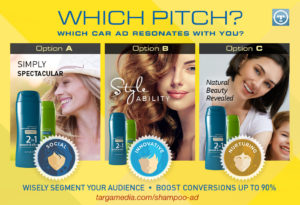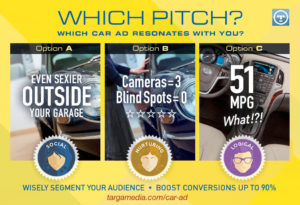
Which Shampoo Ad Resonates with You?

Jason Steed
Owner & CEO
Which Shampoo Ad Resonates with You?
Choosing your favorite shampoo ad involves your own unique motivations. You can probably deduce the differences between these ads, but what was your process for choosing? Did you second-guess your first choice? Was your selection intuitive, or a bit of a chore? Did you choose based on imagery or headline? Your own audience will rely on the motivations that make up their emotional hardwiring.

Let’s Evaluate These Ads
Let’s say you were marketing to potential shampoo buyers. Marketing messages commonly address many customer segments at once, resulting in neutralized and diluted messages with minimal impact. Marketing is much more genuine when you match messages with customer motivations. By defining main motivations, you’re able to craft genuine offers, measure conversions, and boost loyalty. Your ability to make smart connections relies on your ability to correctly define your audience types. This process will deliver measurable results in the form of shortened buying cycles, loyal customers and advocates to your brand.
The Five Primary Motivations
Curious about the stickers of Penney, Starla and Liz? According to Targa Media’s Boxxer Model, there are 5 distinct personas that comprise the 5 major personalities and purchasing motivations. They are Innovative, Logical, Nurturing, Practical and Social. This valuable marketing structure simplifies the approach and lays the groundwork for understanding consumers’ challenges while providing meaningful solutions.
In our shampoo ad example, let’s step through some obvious and subtle differences between each:
- Ad A leads out with practical motivators such as low hype and organized facts. Notice an emphasis on the physical product to help enforce a tangible promise. Other headlines for this audience might be “Just Wash and Go” or “End Split Ends” or “All-in-One Guarantee.” More about what motivates Penney.
- Ad B leads out with innovative motivators such as custom applications and competitive undertones. Innovative shoppers are naturally creative, seeking control, even living on the edge with excitement and uncertainty. If you chose this ad you are likely a strong-willed risk-taker, often welcoming a challenge. More about what motivates Starla.
- Ad C leads out with nurturing motivators such as empathy and concern for wellbeing. A nurturing person is driven by emotional sensitivity and sensibility. If you chose this ad then you likely read non-verbal cues. You might consider yourself spiritually minded and empathetic. You learn through experiences rather than theory, and you resent insincerity. More about what motivates Liz.
It’s important to remember that motivation segmentation is different from demographic segmentation. It’s common for demographics to shift over time, but people are primarily true to their personalities and motivations throughout their lives. For example, your nurturing-minded audience might be in the market for a 2nd car for their growing family, or a student in need of a basic commuter car, or have better financial means going into retirement, but they will remain nurturing-minded. For this reason there’s a real opportunity to capture and utilize emotional psychographics.
Wisely Segmenting Your Audience Boosts Conversions by Up to 90%
Take a close look at your visual focus, headline, and call to action in your email campaigns, digital banners, landing pages, and direct mail pieces. Matching your message with your customer’s motivation boosts conversions in your current campaigns and builds long-term brand loyalty and advocacy.




